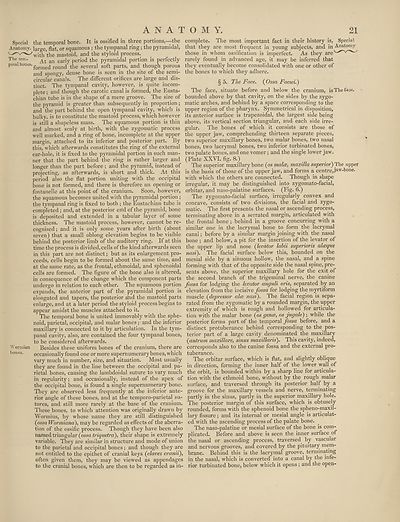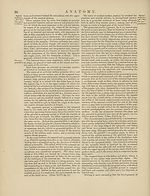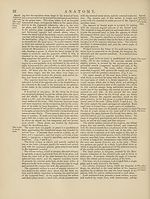Encyclopaedia Britannica > Volume 3, Anatomy-Astronomy
(29) Page 21
Download files
Complete book:
Individual page:
Thumbnail gallery: Grid view | List view

ANATOMY.
21
Special the temporal bone. It is ossified in three portions, . the
Anatomy, large, flat, or squamous ; the tympanal ring; the pyramidal,
with the mastoid, and the styloid process.
The tern- &n ear]y peri0(] the pyramidal portion is perfectly
poral bones. formed roun(i the several soft parts, and though porous
and spongy, dense bone is seen in the site of the semi¬
circular canals. The different orifices are large and dis¬
tinct. The tympanal cavity, however, is quite incom¬
plete ; and though the carotic canal is formed, the Eusta¬
chian tube is in the shape of a mere groove. The size of
the pyramid is greater than subsequently in proportion;
and the part behind the open tympanal cavity, which is
bulky, is to constitute the mastoid process, which however
is still a shapeless mass. The squamous portion is thin
and almost scaly at birth, with the zygomatic process
well marked, and a ring of bone, incomplete at the upper
margin, attached to its inferior and posterior part. By
this, which afterwards constitutes the ring of the external
ear-hole, it is fixed to the pyramidal portion in such man¬
ner that the part behind the ring is rather larger and
longer than the part before ; and the pyramid, instead of
projecting, as afterwards, is short and thick. At this
period also the flat portion uniting with the occipital
bone is not formed, and there is therefore an opening or
fontanelle at this point of the cranium. Soon, however,
the squamous becomes united with the pyramidal portion ;
the tympanal ring is fixed to both ; the Eustachian tube is
completed; and, at the posterior end of the pyramid, bone
is deposited and extended in a tabular layer of some
thickness. The mastoid process, however, cannot be re¬
cognised; and it is only some years after birth (about
seven) that a small oblong elevation begins to be visible
behind the posterior limb of the auditory ring. If at this
time the process is divided, cells of the kind afterwards seen
in this part are not distinct; but as its enlargement pro¬
ceeds, cells begin to be formed about the same time, and
at the same rate, as the frontal, ethmoidal, and sphenoidal
cells are formed. The figure of the bone also is altered,
in consequence of the change which the component parts
undergo in relation to each other. The squamous portion
expands, the anterior part of the pyramidal portion is
elongated and tapers, the posterior and the mastoid parts
enlarge, and at a later period the styloid process begins to
appear amidst the muscles attached to it.
The temporal bone is united immovably with the sphe¬
noid, parietal, occipital, and malar bones ; and the inferior
maxillary is connected to it by articulation. In the tym¬
panal cavity, also, are contained the four tympanal bones,
to be considered afterwards.
Besides these uniform bones of the cranium, there are
occasionally found one or more supernumerary bones, which
vary much in number, size, and situation. Most usually
they are found in the line between the occipital and pa¬
rietal bones, causing the lambdoidal suture to vary much
in regularity; and occasionally, instead of the apex of
the occipital bone, is found a single supernumerary bone.
They are observed less frequently at the inferior ante¬
rior angle of these bones, and at the temporo-parietal su¬
tures, and still more rarely at the base of the cranium.
These bones, to which attention was originally drawn by
Wormius, by whose name they are still distinguished
(ossa Wormiana), may be regarded as effects of the aberra¬
tion of the ossific process. Though they have been also
named triangular (ossa triquetrd), their shape is extremely
variable. They are similar in structure and mode of union
to the parietal and occipital bones; and though they are
not entitled to the epithet of cranial keys (claves cranii),
often given them, they may be viewed as appendages
to the cranial bones, which are then to be regarded as in¬
Wormian
bones.
complete. The most important fact in their history is, Special
that they are most frequent in young subjects, and in Anatomy
those in whom ossification is imperfect. As they are
rarely found in advanced age, it may be inferred that
they eventually become consolidated with one or other of
the bones to which they adhere.
§ 5. The Face. (Ossa Faciei.)
The face, situate before and below the cranium, is The foie,
bounded above by that cavity, on the sides by the zygo¬
matic arches, and behind by a space corresponding to the
upper region of the pharynx. Symmetrical in disposition,
its anterior surface is trapezoidal, the largest side being
above, its vertical section triangular, and each side irre¬
gular. The bones of which it consists are those of
the upper jaw, comprehending thirteen separate pieces,
two superior maxillary bones, two malar bones, two nasal
bones, two lacrymal bones, two inferior turbinated bones,
two palate bones, and one vomer; and the single lower jaw.
(Plate XXVI. fig. 8.)
The superior maxillary bone (osmalce, maxilla superior) The upper
is the basis of those of the upper jaw, and forms a centre,jaw-b°ne*
with which the others are connected. Though in shape
irregular, it may be distinguished into zygomato-facial,
orbitar, and naso-palatine surfaces. (Fig- 6-)
The zygomato-facial surface, irregularly convex and
concave, consists of two divisions, the facial and zygo¬
matic. The first presents the nasal or ascending process,
terminating above in a serrated margin, articulated with
the frontal bone; behind in a groove concurring with a
similar one in the lacrymal bone to form the lacrymal
canal; before by a similar margin joining with the nasal
bone ; and below, a pit for the insertion of the levator of
the upper lip and nose (levator labii superioris aleeque
nasi). The facial surface below this, bounded on the
mesial side by a sinuous hollow, the nasal, and a spine
forming with that of the opposite side the nasal spine, pre¬
sents above, the superior maxillary hole for the exit of
the second branch of the trigeminal nerve, the canine
fossa for lodging the levator anguli oris, separated by an
elevation from the incisive fossa for lodging the myrtiform
muscle (depressor alee nasi). The facial region is sepa¬
rated from the zygomatic by a rounded margin, the upper
extremity of which is rough and hollowed for articula¬
tion with the malar bone (os gence, os jugale) ; while the
posterior forms part of the temporal fossa before, and a
distinct protuberance behind corresponding to the pos¬
terior part of a large cavity denominated the maxillary
(antrum maxillare, sinus maxillaris). This cavity, indeed,
corresponds also to the canine fossa and the external pro¬
tuberance.
The orbitar surface, which is flat, and slightly oblique
in direction, forming the inner half of the lower wall of
the orbit, is bounded within by a sharp line for articula¬
tion with the ethmoid bone, without by the rough malar
surface, and traversed through its posterior half by a
groove for the maxillary vessels and nerve, terminating
partly in the sinus, partly in the superior maxillary hole.
The posterior margin of this surface, which is obtusely
rounded, forms with the sphenoid bone the spheno-maxil-
lary fissure; and its internal or mesial angle is articulat¬
ed with the ascending process of the palate bone.
The naso-palatine or mesial surface of the bone is com¬
plicated. Before and above is seen the inner surface of
the nasal or ascending process, traversed by vascular
and nervous grooves, and covered by the pituitary mem¬
brane. Behind this is the lacrymal groove, terminating
in the nasal, which is converted into a canal by the infe¬
rior turbinated bone, below which it opens; and the open-
21
Special the temporal bone. It is ossified in three portions, . the
Anatomy, large, flat, or squamous ; the tympanal ring; the pyramidal,
with the mastoid, and the styloid process.
The tern- &n ear]y peri0(] the pyramidal portion is perfectly
poral bones. formed roun(i the several soft parts, and though porous
and spongy, dense bone is seen in the site of the semi¬
circular canals. The different orifices are large and dis¬
tinct. The tympanal cavity, however, is quite incom¬
plete ; and though the carotic canal is formed, the Eusta¬
chian tube is in the shape of a mere groove. The size of
the pyramid is greater than subsequently in proportion;
and the part behind the open tympanal cavity, which is
bulky, is to constitute the mastoid process, which however
is still a shapeless mass. The squamous portion is thin
and almost scaly at birth, with the zygomatic process
well marked, and a ring of bone, incomplete at the upper
margin, attached to its inferior and posterior part. By
this, which afterwards constitutes the ring of the external
ear-hole, it is fixed to the pyramidal portion in such man¬
ner that the part behind the ring is rather larger and
longer than the part before ; and the pyramid, instead of
projecting, as afterwards, is short and thick. At this
period also the flat portion uniting with the occipital
bone is not formed, and there is therefore an opening or
fontanelle at this point of the cranium. Soon, however,
the squamous becomes united with the pyramidal portion ;
the tympanal ring is fixed to both ; the Eustachian tube is
completed; and, at the posterior end of the pyramid, bone
is deposited and extended in a tabular layer of some
thickness. The mastoid process, however, cannot be re¬
cognised; and it is only some years after birth (about
seven) that a small oblong elevation begins to be visible
behind the posterior limb of the auditory ring. If at this
time the process is divided, cells of the kind afterwards seen
in this part are not distinct; but as its enlargement pro¬
ceeds, cells begin to be formed about the same time, and
at the same rate, as the frontal, ethmoidal, and sphenoidal
cells are formed. The figure of the bone also is altered,
in consequence of the change which the component parts
undergo in relation to each other. The squamous portion
expands, the anterior part of the pyramidal portion is
elongated and tapers, the posterior and the mastoid parts
enlarge, and at a later period the styloid process begins to
appear amidst the muscles attached to it.
The temporal bone is united immovably with the sphe¬
noid, parietal, occipital, and malar bones ; and the inferior
maxillary is connected to it by articulation. In the tym¬
panal cavity, also, are contained the four tympanal bones,
to be considered afterwards.
Besides these uniform bones of the cranium, there are
occasionally found one or more supernumerary bones, which
vary much in number, size, and situation. Most usually
they are found in the line between the occipital and pa¬
rietal bones, causing the lambdoidal suture to vary much
in regularity; and occasionally, instead of the apex of
the occipital bone, is found a single supernumerary bone.
They are observed less frequently at the inferior ante¬
rior angle of these bones, and at the temporo-parietal su¬
tures, and still more rarely at the base of the cranium.
These bones, to which attention was originally drawn by
Wormius, by whose name they are still distinguished
(ossa Wormiana), may be regarded as effects of the aberra¬
tion of the ossific process. Though they have been also
named triangular (ossa triquetrd), their shape is extremely
variable. They are similar in structure and mode of union
to the parietal and occipital bones; and though they are
not entitled to the epithet of cranial keys (claves cranii),
often given them, they may be viewed as appendages
to the cranial bones, which are then to be regarded as in¬
Wormian
bones.
complete. The most important fact in their history is, Special
that they are most frequent in young subjects, and in Anatomy
those in whom ossification is imperfect. As they are
rarely found in advanced age, it may be inferred that
they eventually become consolidated with one or other of
the bones to which they adhere.
§ 5. The Face. (Ossa Faciei.)
The face, situate before and below the cranium, is The foie,
bounded above by that cavity, on the sides by the zygo¬
matic arches, and behind by a space corresponding to the
upper region of the pharynx. Symmetrical in disposition,
its anterior surface is trapezoidal, the largest side being
above, its vertical section triangular, and each side irre¬
gular. The bones of which it consists are those of
the upper jaw, comprehending thirteen separate pieces,
two superior maxillary bones, two malar bones, two nasal
bones, two lacrymal bones, two inferior turbinated bones,
two palate bones, and one vomer; and the single lower jaw.
(Plate XXVI. fig. 8.)
The superior maxillary bone (osmalce, maxilla superior) The upper
is the basis of those of the upper jaw, and forms a centre,jaw-b°ne*
with which the others are connected. Though in shape
irregular, it may be distinguished into zygomato-facial,
orbitar, and naso-palatine surfaces. (Fig- 6-)
The zygomato-facial surface, irregularly convex and
concave, consists of two divisions, the facial and zygo¬
matic. The first presents the nasal or ascending process,
terminating above in a serrated margin, articulated with
the frontal bone; behind in a groove concurring with a
similar one in the lacrymal bone to form the lacrymal
canal; before by a similar margin joining with the nasal
bone ; and below, a pit for the insertion of the levator of
the upper lip and nose (levator labii superioris aleeque
nasi). The facial surface below this, bounded on the
mesial side by a sinuous hollow, the nasal, and a spine
forming with that of the opposite side the nasal spine, pre¬
sents above, the superior maxillary hole for the exit of
the second branch of the trigeminal nerve, the canine
fossa for lodging the levator anguli oris, separated by an
elevation from the incisive fossa for lodging the myrtiform
muscle (depressor alee nasi). The facial region is sepa¬
rated from the zygomatic by a rounded margin, the upper
extremity of which is rough and hollowed for articula¬
tion with the malar bone (os gence, os jugale) ; while the
posterior forms part of the temporal fossa before, and a
distinct protuberance behind corresponding to the pos¬
terior part of a large cavity denominated the maxillary
(antrum maxillare, sinus maxillaris). This cavity, indeed,
corresponds also to the canine fossa and the external pro¬
tuberance.
The orbitar surface, which is flat, and slightly oblique
in direction, forming the inner half of the lower wall of
the orbit, is bounded within by a sharp line for articula¬
tion with the ethmoid bone, without by the rough malar
surface, and traversed through its posterior half by a
groove for the maxillary vessels and nerve, terminating
partly in the sinus, partly in the superior maxillary hole.
The posterior margin of this surface, which is obtusely
rounded, forms with the sphenoid bone the spheno-maxil-
lary fissure; and its internal or mesial angle is articulat¬
ed with the ascending process of the palate bone.
The naso-palatine or mesial surface of the bone is com¬
plicated. Before and above is seen the inner surface of
the nasal or ascending process, traversed by vascular
and nervous grooves, and covered by the pituitary mem¬
brane. Behind this is the lacrymal groove, terminating
in the nasal, which is converted into a canal by the infe¬
rior turbinated bone, below which it opens; and the open-
Set display mode to:
![]() Universal Viewer |
Universal Viewer | ![]() Mirador |
Large image | Transcription
Mirador |
Large image | Transcription
Images and transcriptions on this page, including medium image downloads, may be used under the Creative Commons Attribution 4.0 International Licence unless otherwise stated. ![]()
| Encyclopaedia Britannica > Encyclopaedia Britannica > Volume 3, Anatomy-Astronomy > (29) Page 21 |
|---|
| Permanent URL | https://digital.nls.uk/193757725 |
|---|
| Attribution and copyright: |
|
|---|---|
| Shelfmark | EB.16 |
|---|---|
| Description | Ten editions of 'Encyclopaedia Britannica', issued from 1768-1903, in 231 volumes. Originally issued in 100 weekly parts (3 volumes) between 1768 and 1771 by publishers: Colin Macfarquhar and Andrew Bell (Edinburgh); editor: William Smellie: engraver: Andrew Bell. Expanded editions in the 19th century featured more volumes and contributions from leading experts in their fields. Managed and published in Edinburgh up to the 9th edition (25 volumes, from 1875-1889); the 10th edition (1902-1903) re-issued the 9th edition, with 11 supplementary volumes. |
|---|---|
| Additional NLS resources: |
|

